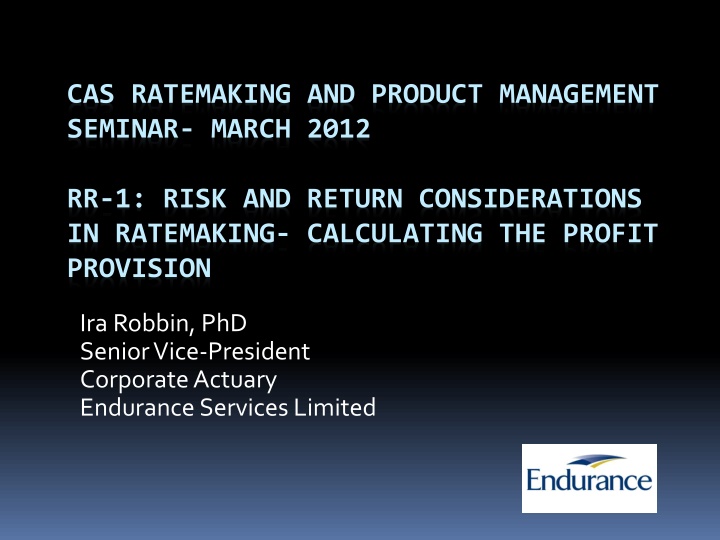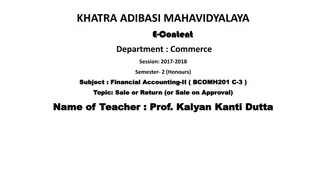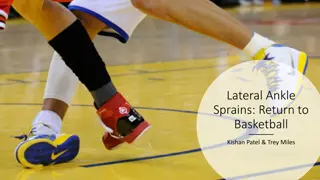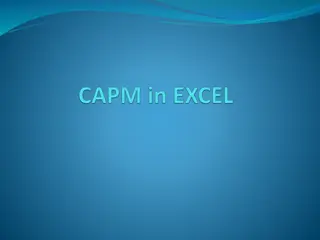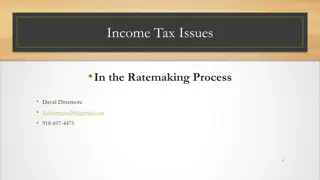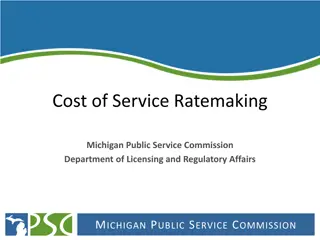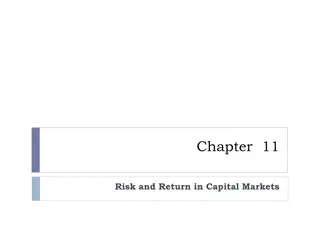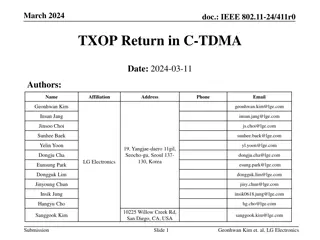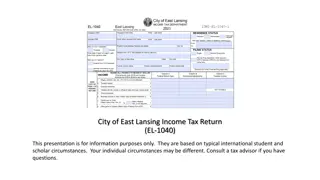Risk and Return Considerations in Ratemaking
This seminar delves into the calculation of the profit provision in insurance ratemaking, discussing methods without focusing on premium charges for specific consumers. The session emphasizes adherence to antitrust laws and provides insights on different approaches to underwriting profit computation, corporate context, and ROE models.
Download Presentation

Please find below an Image/Link to download the presentation.
The content on the website is provided AS IS for your information and personal use only. It may not be sold, licensed, or shared on other websites without obtaining consent from the author.If you encounter any issues during the download, it is possible that the publisher has removed the file from their server.
You are allowed to download the files provided on this website for personal or commercial use, subject to the condition that they are used lawfully. All files are the property of their respective owners.
The content on the website is provided AS IS for your information and personal use only. It may not be sold, licensed, or shared on other websites without obtaining consent from the author.
E N D
Presentation Transcript
CAS RATEMAKING AND PRODUCT MANAGEMENT SEMINAR- MARCH 2012 RR-1: RISK AND RETURN CONSIDERATIONS IN RATEMAKING- CALCULATING THE PROFIT PROVISION Ira Robbin, PhD Senior Vice-President Corporate Actuary Endurance Services Limited
2 Ground Rules The purpose of this session is to educate actuaries in various methods used to compute the underwriting profit provision. There will be no discussion of the adequacy of the premium charge for any particular consumer or particular class of consumers. All attendees should scrupulously follow anti- trust guidelines. 2
3 CAS Antitrust Notice The Casualty Actuarial Society is committed to adhering strictly to the letter and spirit of the antitrust laws. Seminars conducted under the auspices of the CAS are designed solely to provide a forum for the expression of various points of view on topics described in the programs or agendas for such meetings. Under no circumstances shall CAS seminars be used as a means for competing companies or firms to reach any understanding expressed or implied that restricts competition or in any way impairs the ability of members to exercise independent business judgment regarding matters affecting competition. It is the responsibility of all seminar participants to be aware of antitrust regulations, to prevent any written or verbal discussions that appear to violate these laws, and to adhere in every respect to the CAS antitrust compliance policy. 3
4 Disclaimers No statements of the Endurance corporate position will be made or should be inferred. While some methods may be similar to methods promulgated by regulatory authorities, practitioners should follow actual regulatory instructions. While some methods to be discussed are similar to methods in the presenter s Study Note on the CAS Syllabus, students should consult the Study Note for exact details. 4
Cautions Examples are for illustrative purposes only. Do not use the results from any example in real- world applications. The profit load indicated from a model often depends critically on the assumptions and parameters. For ease of presentation, assumptions have been greatly simplified and hypothetical parameters have been selected. There may be a quiz at the end so pay attention! 5
6 Overview UW Profit Basics Overview of Different Methods Corporate and Regulatory Contexts Offset Formulas ROE Models DCF and Risk-Adjusted DCF Conclusion 6
Different Types of UW Profit Actual Achieved Booked to Date vs Ultimate PY, AY, CY Direct, Gross, Ceded, Net Stat vs GAAP Provision in Manual Rate Indicated, Filed, Approved Per Risk vs Book of Business Provision in Charged Premium Competition and Market cycles 7
UW Profit: Basic Equations U = P-L-X = UPM*P L = Loss + LAE X = Expense including premium tax CR = (L+X)/P= 1- UPM UPM of 100% yields CR =200% X = FX +VXR*P FX = Fixed expense VXR = Variable expense ratio P= (L+FX)/(1-VXR-UPM) 8
UW Profit Provision Chart Profit Provision Fixed Expense Premium Variable Expense Loss + LAE Provision 9
10 UPM Formula Examples L=50 FX=30 VXR = 15% UPM = 5% + (50 1 30) .05 = = P 100 .15 VXR=15% UPM = -1% + (50 .15 30) ( .01) = = P 93 1 10
11 UPM Calculation Approaches Investment Income Adjustment Start with traditional profit loads Adjust for investment income Total Return Select target return and determine capital Compute total return on capital Find profit needed to hit target return Economic Components Needed premium is sum of discounted components Risk reflected in discounting 11
UW Profit Provision Methods Investment Income Offset 1. CY Investment Offset (State X) 2. PV Differential 3. CY ROS or ROE Total Return 4. IRR on Equity Flow 5. PVI/PVE 6. DCF Economic Components 7. Risk-Adjusted DCF 12
What is the right Underwriting Profit Provision ? 13
14 Right Method Depends on Context Regulatory Philosophy of regulation State controlled vs free market approaches Personal Lines and WC vs Commercial Prior approval/File and use/Use and file Corporate UPM targets by LOB or Business Segment Pricing for target return net of risk over cycle Pricing hurdle 14
15 Recap of UW Profit Regulation 1920 s 1970 s: Low interest era No consideration of investment income 5.0% UPM for most lines (2.5% for WC) 1970 s 90 s: High rate era Investment income offsets CAPM, DCF and Risk-Adjusted DCF IRR on Equity Flows and PVI/PVE Late 1990s-2000-2010: Low rate era Less interest in Inv Income regulation Lower loss costs Competitive rate reductions More open competition 15
16 CY Investment Income Offset (State X) UPM = UPM IIOffset 0 UPM0 = Traditional UPM IIOffset = Investment Income Offset = IIOffset AFIT i * PHSF PHSF = Policyholder supplied funds Interest rate after-tax from CY inv inc earned Actual portfolio mix of invested assets 16
17 Policyholder Supplier Funds Two Components UEPR (1 PPACQR ) RECV UEPR net of Pre-Paid Acquisition Cost Reduce for Receivables ) ( LRES PLR INCL PLR = Permissible Loss Ratio CY ratio of L+LAE Reserves to Incurred 17
CY II Offset- Example UEPR LRES 400 1,200 Earned Prem Inc d Loss+LAE 1,000 800 RECV UPM0 260 5.0% PPACQR PLR After-tax Yield 10.0% 60.0% 2.0% PHSF = ((400/1000) (1-.1)-.26) + .6 1.5 =1.00 UPM = .05 - .02 1.00 = 3.0% 18
19 Offset for PV Loss Differential UPM = UPM PVDELLR 0 UPM0 = Traditional UPM ( ) = PVDELLR PLR PV ( x x ) PV ( ) x x 0 PLR = Permissible Loss ratio x x = Loss pattern for review LOB x x0 0 = Loss pattern for reference LOB PV using risk-free new money rate after-tax 19
20 PV Differential Offset- Example PV(REF Loss Pattern) PV(REV Loss Pattern) Risk-free New Money Rate after tax 99.0% 95.0% 2.0% PLR Traditional UPM PVDELLR = (.99-.95)*.60 = 2.4% UPM = .050-.024 = 2.6% 60.0% 5.0% 20
CY ROS Equation + INC S U INV S T = = ROS 21
ROS Decomposition = ROS UPM (1 + + t ) PHSF Premium to Surplus Ratio AT i i AT 22
23 CY ROS ROE vs ROS GAAP vs STAT Going-concern vs Solvency STAT defined by state regulation Calendar Yr vs Policy Yr ROE is CY Past decisions impact this CY Ratemaking is PY and prospective 23
24 Surplus in ROS Equation S = Target Statutory Surplus S = P/ = Premium-to-Surplus leverage ratio varies by LOB Equity vs Surplus 24
Solve for UPM PHSF ROS -i -i target AT AT UPM= (1-t) 25
UPM to Hit CY ROS- Example % of P PHSF 110.00% 2.00 2.00% 35.00% 12.00% II afit on PHSF II afit on S (1-t)UPM Total 2.20% 1.00% 2.80% 6.00% After-tax yield tax rate target ROS Surplus ROS 50.00% 12.00% UPM 4.31% 26
27 IRR on Equity Flows Internal Rate of Return on Individual Policy or Book of Business or LOB Can be used in regulatory or corporate contexts Equity flow: flow of $ between an equity investor and the insurance company Model prospective equity flows for hypothetical insurance company writing one policy Use accounting rules, capital requirements, and other assumptions to derive income and surplus each time period. EQF = INC S 27
Equity Flow Diagram UW Cash Flows Invest Inc Income Tax Single Policy Company Balance Sheet Income Statement Assets Investables Receivables Recoverables Other Liabs and Surp UEPR Loss Reserves Expense Reserves Surplus UW Gain Investment Income Earned Realized Capital Gains Taxes Net + - Equity Flows Pool of Equity 28
29 Capital Set Surplus = Required Capital Need to specify amount and duration in model Reflect UW, CAT, and Reserving risk Not an Actual Allocation of Capital Regulatory: RBC, RDS, Solvency II Rating Agencies: S&P, A.M. Best, etc. Book of Business Variation Should high layer excess casualty and primary low limit casualty use the same Other Liab factors? Individual Large Risk or Treaty Variation Adjust for treaty features ( e.g. reinstatements, agg caps) 29
30 Income and Cash Flow UW Gain = EP IncLoss IncExpense Defined by accounting rules Does not depend on UW cash flows Inv Inc = II on Invested Assets Invested Assets Assets- Recvbl s -Recovs Assets = Reserves + Surplus Balance sheet must balance Amounts defined by accounting rules UW Cash flows impact Invested Assets 30
Single Policy Company: UW Income and Cash Flow Earned Prem Paid Prem Inc'd Loss Paid Loss Inc'd Paid UW Expense Expense Income time 0 1 2 3 0 50 50 0 0 100 0 0 30 5 0 0 35 16 10 5 4 35 -30 33 100 62 0 0 62 20 30 12 62 0 0 0 0 3 total 100 31
Single Policy Company: Assets and Investment Income Total Liab Loss Rsv Expense and Inv'stble Assets Inv Rsv Surplus Surplus Recv'ble Income time UEPR 0 1 2 3 100 0 14 9 4 0 40 10 4 0 154 61 20 50 0 0 0 104 61 20 0 0 0 42 12 0 5.2 3.1 1.0 0 0 32
Single Policy Company: Equity Flow and IRR Pre-tax IRR 14.2% UW Inv Total Change in Surplus Equity Flow Income Income Income time 0 1 2 3 -30 33 0.0 5.2 3.1 1.0 9.3 -30.0 38.2 3.1 1.0 12.3 40 -30 -6 -4 -70.0 68.2 9.1 5.0 12.3 0 0 3 total 0 33
IRR Given flows , xt , IRR is the interest rate, y, (if it exists) which solves: = t 0 v x t = t 0 = + 1 v ( 1 y ) IRR extends the concept of the interest rate on a loan to a more general situation 34
IRR on Equity Flows Typical EQ Flows in P/C insurance First flow is negative Later flows are positive One sign change IRR on EQ Flow well-defined Solve for premium to hit IRR target 35
PVI/PVE ROE on Individual Policy, Book of Business or LOB Can be used in regulatory or corporate contexts PV(INC,r ) PV(EQB,r ) = f PVI/PVE f Equity Balance Generalizes ROE = Income/Equity to apply to multi- year model PV of income at end of year 1 PV of balance sheet account (Equity Balance) 36
Single Policy Company: PVI/PVE PVI/PVE = 9.60 / 53.15 = 18.1% PV t =1 Income Equity balance PV Equity balance time Income -30.00 37.20 3.10 1.05 11.35 year 0 1 2 3 -31.50 37.20 2.95 0.95 9.60 1 2 3 40.00 10.00 4.00 54.00 40.00 9.52 3.63 53.15 total total 37
PVI/PVE Approximation Compute PVI /PVE as sum of: PV of UW Cash Flows at immunized risk-free rate + Risk-free rate Then net out taxes ( ignores true tax pattern under Tax Reform Act of 86) PV (UWCF,r ) 1 = + f (1 t ) PVI/PVE r f PV(EQB,r ) f 38
Discounted Cash Flow Prospective cash flow approach based on application of 1950-2005 era economic theory kr = + E r r ( [ ] ) UPM f m f k = funds generating coefficient rf = risk-free new money rate rm= market return = systematic covariance 39
40 Applying CAPM to Insurance CAPM risk reward concept Reward for taking systematic risk No reward for diversifiable risk Beta =Cov of Company Stock with Market Insurance Betas by LOB? Few single LOB insurance companies Beta=Cov of LOB UPM with stock market? Backward results not same as forward-looking prices? Tax Adjustment of UPM Add in tax on investment income on ( assets offsetting) Surplus 40
DCF - Example Risk-free rate 2.0% Funds Generating Coefficient 1.30 Beta for LOB E[Market yield] UPM = -1.30*.02+ 1.25(.06-.02) = 2.4% 1.25 6.0% 41
42 Risk-Adjusted DCF Solve for UPM so that: = PV(P, r ) f PV(L, r ) PV(X, r ) PV(FIT, r ) + + A f f rf = risk-free new money rate rA = risk-adjusted rate FIT = income tax including tax on inv inc on Surplus Loss discounted at risk-adjusted rate 42
43 Risk-Adjusted Rate rA = rf + ( rm] rf ) = Cov of liabilities with market While >0 for assets, the here is for liabilities. Thus: <0 and rA < rf How to get by LOB? When rf is low, we can get a risk-adjusted rate less than 0 since . 43
Risk-Adjusted DCF Example Computed with Risk-free Computed with Risk- Adjusted Rate Rate 0.98 PV Factor for Loss 1.01 FV PV Factor Discounted Loss Fixed Expense Variable Expense Total 60.00 25.00 15.00 100.00 1.01 1.00 1.00 60.60 25.00 15.00 100.60 Premium 100.60 1.00 100.60 Combined Ratio UPM 99.4% 0.6% 44
Interest Rate and Surplus Comparison Methods CY Invesment Offset Interest Rate CY Inv Earned Surplus N/A PV Loss Differential Offset Risk-free New Money N/A CY ROE CY Inv Earned P/S Ratio IRR on Equity Flows Risk-free New Money Required Capital Results Highly Dependent on Surplus assumption PVI/PVE Risk-free New Money DCF Risk-free New Money P/S Ratio or Capital Model Results marginally dependent on Surplus assumtions Risk-adjusted DCF Risk Adjusted New Money 45
46 Conclusion Use appropriate method for situation Select parameters consistent with method used Questions 46
